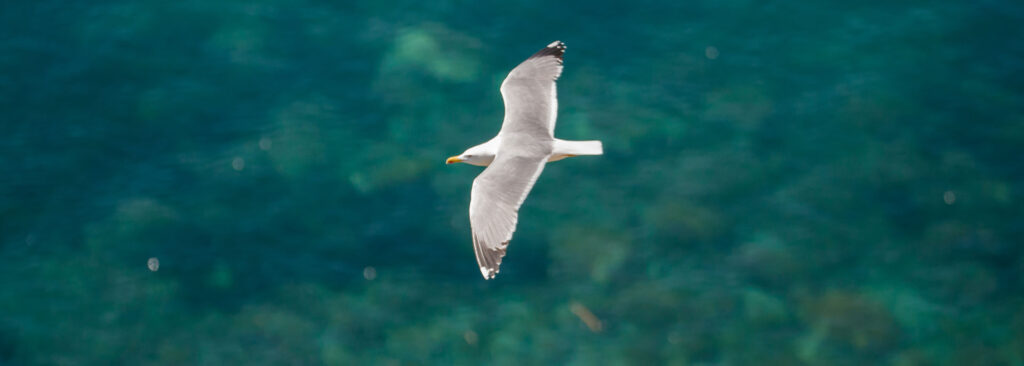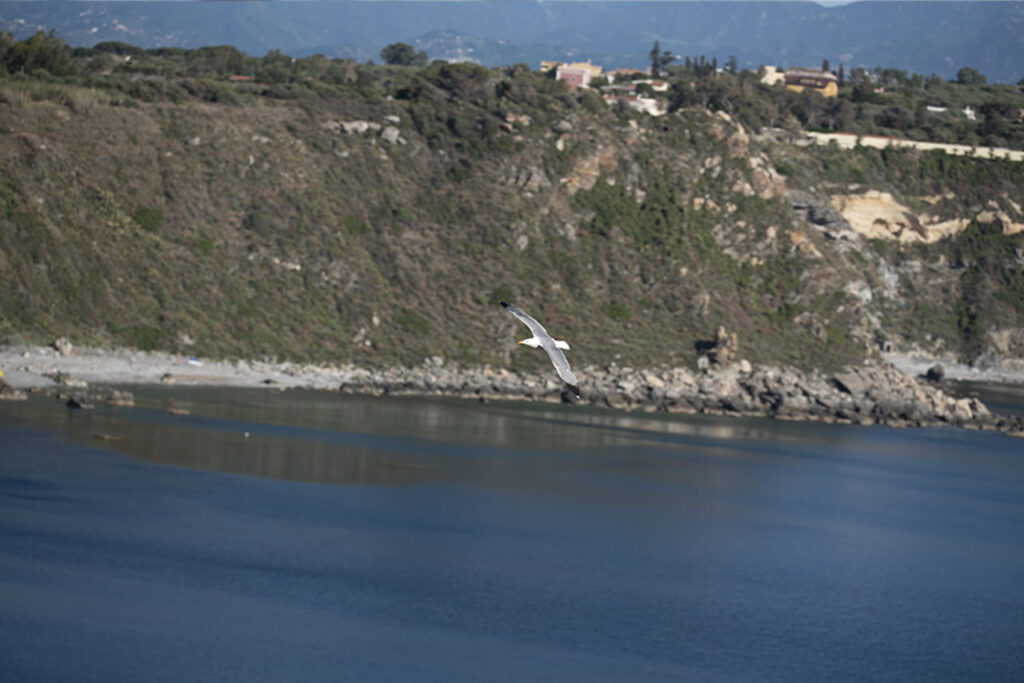Milazzo's natural environment, although modest in size, is home to various animal species. Once, here, as in the rest of Sicily, there were animals that are now unfortunately extinct. These include the brown bear, which disappeared several centuries ago, the roe deer and the red deer, present until the 19th century, the wolf and the griffon vulture, which survived until a few decades ago.
Fauna
It is possible that these and other species lived permanently or occasionally in Milazzo, where, in the Piana area, at least until the Middle Ages, there were several forests. The Swabian and Aragonese royals, in fact, used to practice their hunting in these very areas (Park). We therefore imagine that there was a very rich fauna at that time. Later on, hunting activity, combined with the anthropisation of the territory, if not man's carelessness and rapacity, caused the disappearance of many species.
Another animal that probably lived on the cliffs and in the caves of our Promontory in the past is the monk seal (Monachus monachus). This animal, the only pinniped in the Mediterranean, where it was common until the 19th century, has disappeared from our area due to hunting. Today it only survives along the coasts of Greece, Sardinia and North Africa. A hypothetical 'return' of this animal to the coasts of Milazzo is almost impossible, as our coasts are far too disturbed by the presence of man.
With the establishment of nature reserves, on the other hand, it is possible that many birds will return to stop over during their migrations or even to nest, and that many mammals, present in the nearby Peloritani mountains, such as the fox, dormouse and marten, will return to live permanently in our area.

[ MAMMALS ]
The wild rabbit (Oryctolagus cuniculus) is the most widespread and visible mammal in the Milazzo area, especially in the Promontorio area. This animal lives in large colonies and digs its burrows in the ground, linking them to one another through dense networks of tunnels that allow it to hide and escape from possible dangers. It is a very prolific animal, whose population is, however, reduced by periodic viral diseases and hunting activity.
The Weasel (Mustela nivalis), known in jargon as 'paddottula'. , is an animal widespread almost throughout the territory, but not very visible as it eludes the presence of man. It is mainly active at night and at dusk. Belonging to the Mustelidae family, it is the smallest of the carnivores and almost certainly the only carnivore of the Milazzo fauna.
The tiny mustel (Suncus etruscus), the reddish crocidura (Crocidura russula) and the lesser crocidura (Crocidura suaveolens) are insectivorous shrews that can be observed in the gardens of houses.
The hedgehog (Erinaceus europaeus) is the largest of the insectivores. Its prey includes insects, molluscs and earthworms, occasionally reptiles (vipers) and small mammals. Unfortunately, this small animal often falls victim to cars and pesticides. But despite this it is easily visible at dawn, dusk and at night with the help of artificial light, especially during the non-winter months.
In the Milazzo area, rodents mostly belong to the subfamily Muridae (rats). Some species, such as the black rat (Rattus rattus), the keyhole rat (Rattus norvegicus) and the house mouse (Mus musculus subsp. Domesticus) proliferate in areas associated with built-up areas and human settlements (sewers, warehouses, dumps etc.). The wild mouse (Apodemus sylvaticus) is a small to medium-sized mouse that can be observed in natural environments. Very active at night, it is often prey to weasels and various nocturnal birds of prey.
[ ANPHIBI ]
Among the various species, amphibians are the ones that have been most affected by the process of anthropisation of the territory. With the gradual disappearance of wetlands (ponds, streams, ditches), many species that require spaces such as those listed above for their survival and reproduction have also disappeared.
In the Milazzese territory, the most widespread species are the tree frog (Hyla intermedia) and the painted discoglossus (Discoglossus pictus), a strictly protected species. These two species of animals live mostly in the area of the Piana di Milazzo, especially near the Mela stream (Bastione, San Marco, Fiumarella, Santa Marina). The painted tree frog and the painted discoglossus are almost absent in the Promontory areas.
The ditch frog (Rana lessonae), rarely found in the Plain, can be seen during spring and summer in water-filled irrigation pools. Lastly, the common toad (Bufo bufo), popularly known as the 'buffa', has totally disappeared from Milazzo in recent decades.
[ REPTILES ]
The territory of Milazzo is home to two species of lizards, two species of snake, two geckos and two skinks. The most widespread snake, in man-made and natural environments, is the grass snake (Coluber viridiflavus). It is a completely harmless reptile and easily spotted among low vegetation or on the ground. Mature specimens have a characteristic black colour; younger specimens are olive-grey in colour, with a yellow spot on the head. Popularly, the latter specimens are considered a separate species and called 'òsine'. The coluber viridiflavus is a diurnal reptile, its food mostly consisting of insects (beetles and orthoptera), lizards, small mammals such as rats or mice and occasionally other snakes. The grass snake specimens present in the Promontory area have a peculiarity: they do not hibernate regularly and are therefore visible even in the middle of winter during warm, sunny days. The collared snake (Natrix natrix), known in slang as 'zambaruni', is a very rare snake in Milazzo, whereas until a few decades ago it was very common and well-known among the inhabitants of the Piana. Its disappearance is due to the disappearance of perennial wetlands: ditches, ponds and marshes where it feeds on frogs and tadpoles.
The field lizard (Podarcis sicula) is the most widespread species of reptile. It is present throughout Italy and is well adapted to the presence of man; we can find it in parks and gardens.
A reptile that is very difficult to observe, especially because it lives in much less anthropised places, is the lizard (Lacerta viridis), commonly referred to as 'lucittuluni' (big lizard) because of its larger size. It used to be found much more easily in the reed beds of the countryside, today it is mostly found along the banks of watercourses.
The warty gecko (Hemidactylus turcicus), one of the two gecko species present in the Milazzo area, can be seen mainly at night on the walls of houses as it hunts for insects attracted by light sources. The common gecko (Tarentola mauritanica), also known as the tarantula muraiola, looks very similar to the previous one but tends to get much closer to houses.
The gongilo (Chalcides ocellatus) is a reptile, belonging to the family Scinchidae, which is very shy and difficult to observe. It lives mostly in arid and sandy areas.
The luscengola (Chalcides chalcides) is an animal that is often mistaken for a small snake because it has very small legs. It can rarely be seen in the areas of the Milazzo Plain and prefers to move along damp, grassy slopes and meadows.
The gongilo, green lizard and field lizard are strictly protected species.
[ BIRDS ]
The Milazzese territory with its cliffs, crags, beaches and cultivated fields has always constituted a favourable spot for the refuge, stable or temporary, of various bird species. Some of these places have little degraded and in some cases pristine ecosystems that favour the development of these animal species. Milazzo, moreover, thanks to its favourable geographical position, is an important crossroads of numerous migration routes between Europe, the Mediterranean and Africa. During spring or autumn migrations, many non-breeding species can be observed in flight and sometimes even at rest.
The peregrine falcon (Falcus peregrinus), one of the most interesting species, regularly nests near the coastal cliffs of Milazzo. This animal has an important historical link with the town of Milazzo. In the 13th century, in fact, King Frederick II of Swabia used to train this very species (peregrinus) for hunting with falcons. Today's area known as the Park was, in fact, a 'royal park' where the Swabian and Aragonese sovereigns carried out hunting trips.
The kestrel (Falco tinnunculus) is a diurnal bird of prey nesting almost throughout the territory. Other diurnal birds of prey include the buzzard (Buteo buteo), which is only rarely present, and the honey buzzard (Pernis apivorus), which can be observed in flight over the Piana during spring migration. Other very common species nesting in our area are some nocturnal birds of prey: the scops owl (Otus scops), the little owl (Athene noctua) and the barn owl (Tyto alba).
Birds related to the marine environment are the common gull (Larus ridibundus), wintering (i.e.: a species that spends the winter in the territory), and the herring gull (Larus cachinnans), which, although present throughout the year in the territory, breeds in colonies only in the nearby Aeolian Islands and at Capo Tindari. Along the coast we can also admire cormorants (Phalacrocorax carbo), the tufted cormorant (Phalacrocorax aristotelis), usually wintering and occasional kingfishers (Alcedo atthis), present in Milazzo from autumn to the end of winter.
Other species that nest near cliffs and cliffs are the lonely sparrow (Monticola solitarius) and the wild pigeon (Columba livia).
The imperial raven (Corvus corax) and jackdaw (Corvus monedula) nest near the Promontory. The magpie (Pica pica), commonly referred to as the 'thieving magpie', nests all over the territory and frequents mainly cultivated fields. All three races belong to the corvid family.
During their autumn and spring migrations, various species of migratory water birds stop along the beaches, stream banks and cliffs of the promontory. These are mostly storks of the Ardeidae family, such as the little bittern (Ixobrychus minutus), the little egret (Egretta garzetta) and the grey heron (Ardea cinerea). The former and the latter also nest in areas of Sicily.
Species linked to environments where the presence of man is more intense include the Sardinian sparrow (Passer hispaniolensis), the tree sparrow (Passer montanus), which nest in holes in walls and in trees in country areas, and a species of swallow (Delichon urbica) very frequent in our skies from spring to autumn. It builds its nest in mud under the eaves of buildings and in rock walls.
A very frequent bird, visible especially in gardens and in the countryside, where it builds its nests near orchards, is the blackbird (Turdus merula). The robin (Erithacus rubecula) and the redstart (Phoenicurus ochruros) are only visible in our areas during the winter period. These birds, which are quite accustomed to the presence of man and not very wary, can often be seen in courtyards or on the roofs of houses.
Nesting grounds of hoopoe (Upupa epops) have been found in some areas of the Plain.
Insectivorous species such as the blackcap (Sylvia atricapilla), the river warbler (Cettia cetti) and the Sardinian warbler (Sylvia melanocephala), which belong to the family Silvidae, are very important for the balance of ecosystems. These birds build their nests on the ground or on low vegetation, where they hunt small invertebrates, including some arachnids such as ticks, which, in the absence or inadequate presence of these birds and lizards, shrews, shrews, would proliferate in a way that is very problematic for humans. Infestations of these pests are often due to fires that destroy the habitat of insectivores (thickets, bushes, hedges) and to overgrazing, which encourages the prolification of pests and also hinders the regrowth of spontaneous vegetation.
Other passerines that can be seen during the winter in meadows and cultivated fields include the black bunting (Emberiza cirlus) and a number of finches including the chaffinch (Frigilla coelebs), the greenfinch (Carduelis chloris) and the goldfinch (Carduelis carduelis), which move to the Peloritani area during the breeding season in spring. The goldfinch (Serinus serinus), on the other hand, nests mostly in the orchards of the Milazzese countryside. Recently, the nesting of the yellow wagtail (Motacilla cinerea) has been noted, which until now was only thought to be present in our territory during the winter period.
